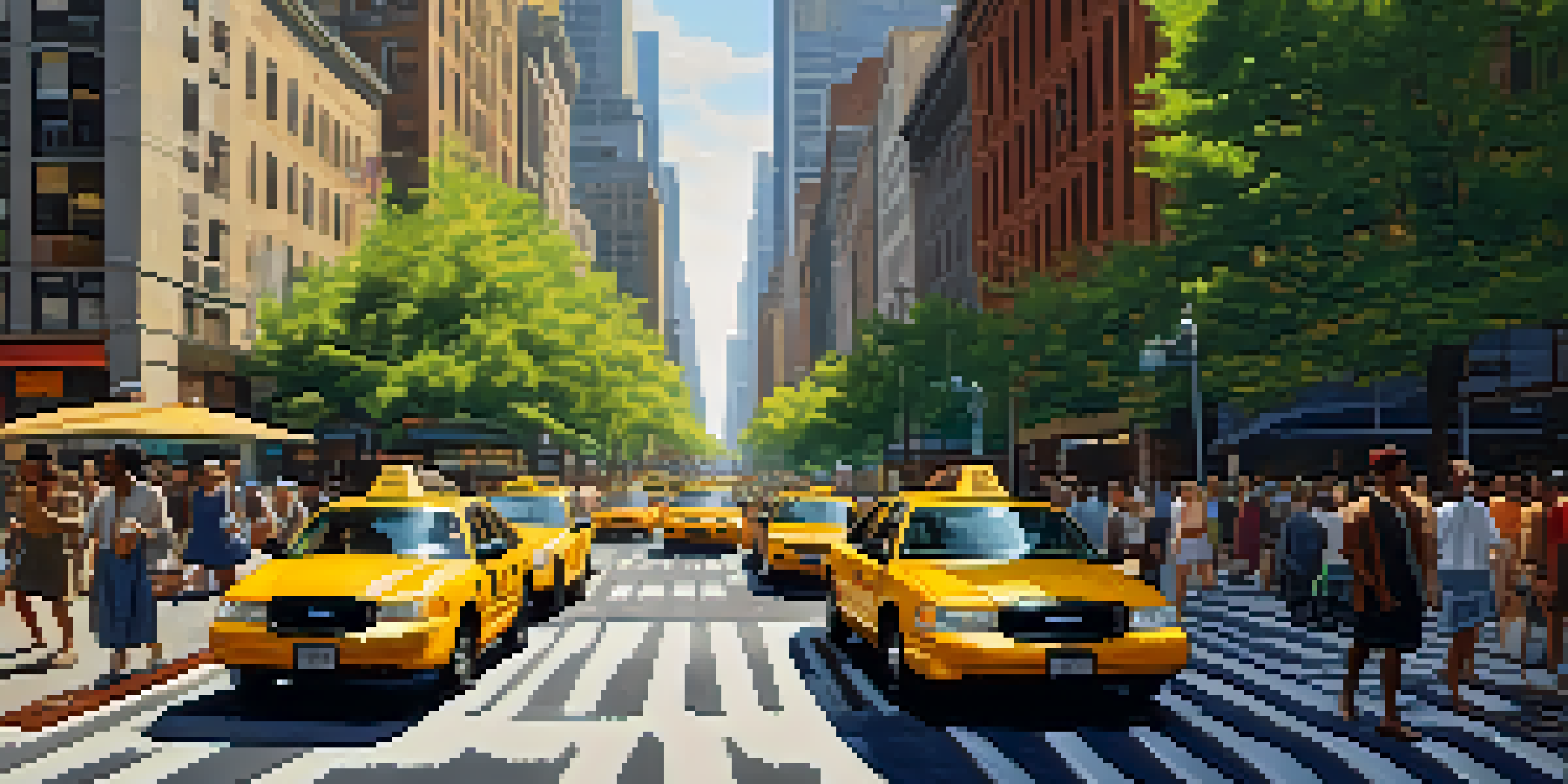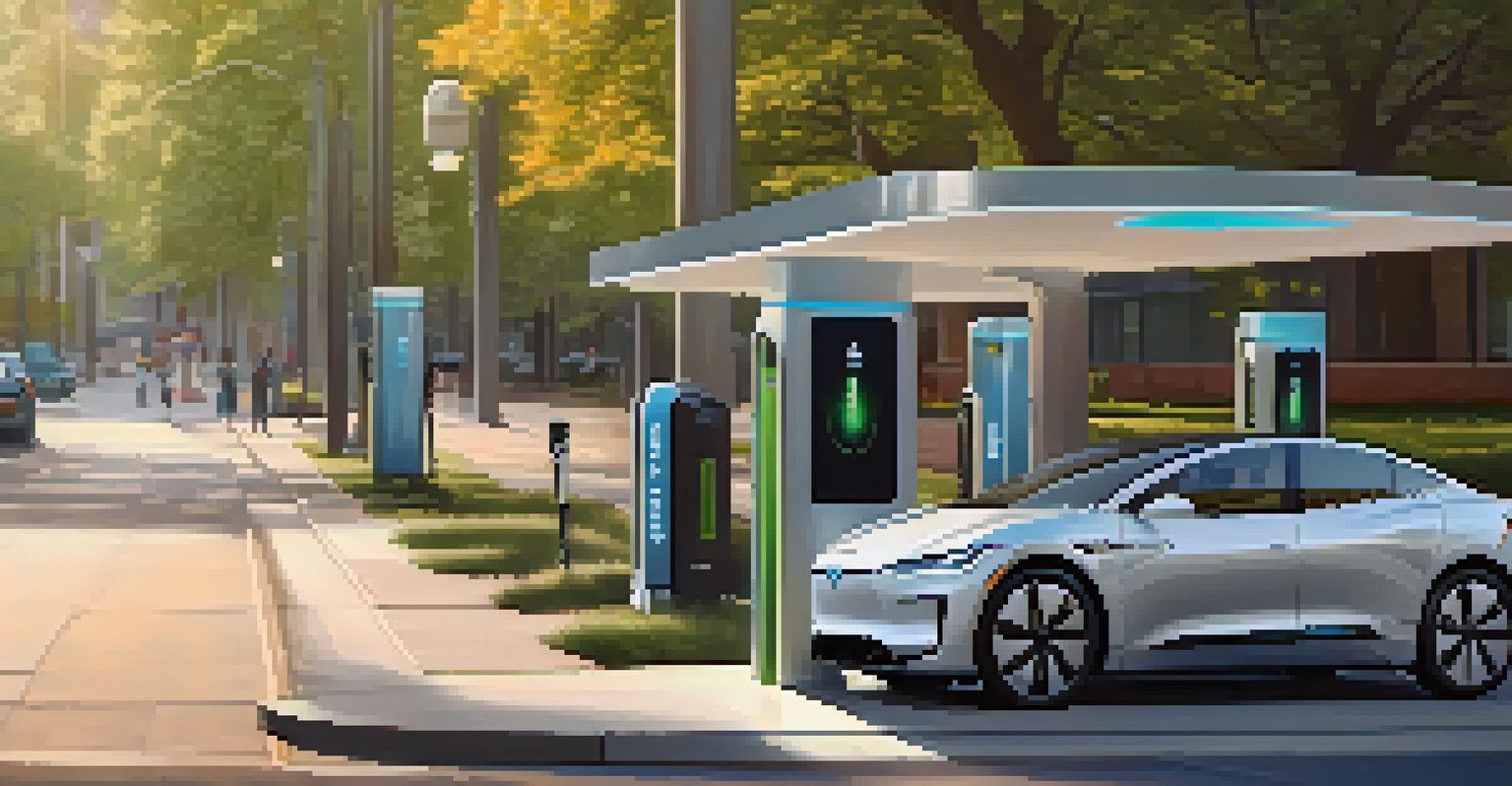Sustainable Transportation Solutions for NYC's Congestion

Understanding NYC's Traffic Congestion Challenges
New York City is notorious for its traffic congestion, with millions of vehicles contributing to gridlock daily. This situation affects not just commuters but also the environment, as increased congestion leads to higher emissions and air pollution. Addressing these challenges is crucial to creating a more livable urban environment for all residents and visitors.
The best way to predict the future is to create it.
The complexity of NYC's transportation system, with its mix of subways, buses, taxis, and private vehicles, adds layers to the congestion problem. While public transport serves millions, many still opt for personal vehicles due to convenience or lack of viable alternatives. Understanding these dynamics is key to developing effective solutions that appeal to both commuters and environmentalists.
As we delve into sustainable transportation solutions, we must first recognize the pressing need for change. Traffic congestion not only wastes time but also strains local economies and public resources. By exploring sustainable alternatives, we can envision a future where transportation is efficient, eco-friendly, and accessible to everyone.
Public Transit: The Backbone of Sustainable Solutions
Public transportation is often hailed as the cornerstone of sustainable urban mobility. In NYC, the subway system can carry over 5 million riders daily, significantly reducing the number of cars on the road. Expanding and improving public transit options can help alleviate congestion and encourage more residents to leave their cars at home.

Investments in bus rapid transit (BRT) and express train services can enhance the efficiency of public transport, making it a more attractive option for commuters. For example, dedicated bus lanes can help buses bypass traffic, allowing for quicker and more reliable service. This improvement can shift public perception and habits, fostering a culture of mass transit usage.
Public Transit Eases Congestion
Expanding and improving public transportation options like subways and buses can significantly reduce traffic congestion in NYC.
Moreover, integrating technology into public transport systems—like real-time tracking apps and electronic payment methods—can enhance user experience. These innovations not only make commuting easier but also promote a shift towards more sustainable transportation habits, reducing the overall dependency on personal vehicles.
Encouraging Biking and Walking as Viable Options
Biking and walking are two of the most sustainable modes of transport available, yet they are often underutilized in a bustling city like NYC. Expanding bike lanes and pedestrian-friendly zones can encourage more residents to opt for these healthier, eco-friendly alternatives. Cities like Amsterdam serve as great examples of how prioritizing cycling infrastructure can significantly reduce congestion.
Sustainability is not a destination, but a journey.
The introduction of bike-sharing programs, such as Citi Bike, has made cycling more accessible to New Yorkers. By providing easy access to bikes, these programs can help reduce the number of short car trips that contribute to congestion. Coupling bike-sharing with improved infrastructure can create a robust cycling culture within the city.
Additionally, initiatives promoting walking—like pedestrian plazas or car-free days—can enhance the urban experience while reducing traffic. These efforts not only cultivate healthier lifestyles but also contribute to a more vibrant and engaging city atmosphere, making walking a more appealing choice for residents.
The Role of Electric Vehicles in Sustainable Transport
Electric vehicles (EVs) are gaining traction as a cleaner alternative to traditional gas-powered cars, making them a crucial part of sustainable transportation solutions. As battery technology improves and charging infrastructure expands, more New Yorkers are considering EVs for their daily commutes. This shift can help reduce greenhouse gas emissions and improve air quality in the city.
Moreover, government incentives for EV purchases and investments in charging stations can accelerate this transition. By making EVs more affordable and convenient, cities can encourage residents to choose electric over fossil-fuel-powered vehicles. New York has already implemented various incentives, but further efforts are needed to broaden EV adoption.
Biking and Walking Boost Sustainability
Promoting biking and walking through better infrastructure can encourage healthier, eco-friendly commuting choices among New Yorkers.
However, it's essential to pair the rise of electric vehicles with renewable energy sources. As more EVs hit the road, ensuring they are powered by clean energy will maximize their environmental benefits. By embracing this holistic approach, NYC can pave the way for a cleaner and more sustainable transportation future.
Carpooling and Ridesharing: Sharing the Road
Carpooling and ridesharing services like Uber and Lyft have transformed the way people navigate NYC. By encouraging shared rides, these services can help reduce the number of vehicles on the road, easing congestion during peak hours. This collective approach not only saves commuters time and money but also lessens the environmental impact of individual car trips.
To further promote carpooling, cities can implement dedicated carpool lanes, making shared travel a more attractive option. Additionally, creating incentives for ridesharing—such as reduced tolls or parking fees—can encourage more people to consider these alternatives. The more we can share the ride, the fewer cars we’ll have on the road.
As technology continues to evolve, we can expect even more innovative solutions in the ridesharing space. For example, apps that match riders with similar destinations can streamline the process and make carpooling easier than ever. By fostering a culture of shared transportation, NYC can significantly mitigate congestion and promote sustainability.
The Impact of Urban Design on Transportation Choices
Urban design plays a critical role in shaping transportation choices and patterns in NYC. By creating mixed-use neighborhoods where homes, workplaces, and amenities are within walking distance, cities can reduce reliance on cars. Well-planned urban spaces encourage walking, biking, and the use of public transportation as preferred modes of travel.
Incorporating green spaces and pedestrian-friendly infrastructure into urban design can enhance the overall experience for residents. Parks, bike paths, and wide sidewalks not only beautify the city but also promote healthier lifestyles. When people enjoy their surroundings, they’re more likely to engage in sustainable transportation options.
Community Engagement Drives Change
Involving residents in the planning process of transportation initiatives fosters support and ensures solutions meet community needs.
Moreover, zoning laws that prioritize sustainable development can further support these efforts. By incentivizing developers to create accessible, eco-friendly buildings, cities can foster an environment that encourages alternative transportation methods. Thoughtful urban design can be the catalyst for a transportation revolution in NYC.
Community Engagement: The Key to Successful Solutions
Engaging the community is essential for the success of any sustainable transportation initiative. By involving residents in the planning process, cities can gain valuable insights into their needs and preferences. This collaborative approach fosters a sense of ownership and responsibility among community members, encouraging them to support and participate in new initiatives.
Public forums, surveys, and workshops can serve as platforms for dialogue between city planners and residents. By listening to feedback and addressing concerns, cities can tailor solutions that resonate with their communities. When people feel heard, they are more likely to embrace changes that promote sustainability.

Additionally, educational campaigns can raise awareness about the benefits of sustainable transportation options. By informing residents about the environmental, health, and economic advantages, cities can inspire more individuals to make conscious choices. Community engagement is not just about gathering input; it’s about building a movement towards a more sustainable future.